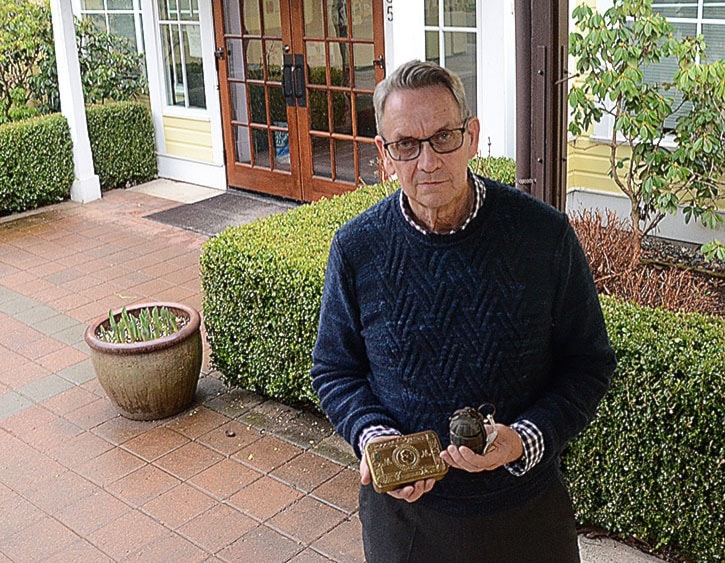In the summer of 1914, 91ԭ�� was a small farming and logging town, with an estimated population of just 3,500.
Yet 400 adult men would leave over the next four years, donning the khaki uniforms of the Canadian Expeditionary Corps.
“About one in 10 did not return,” said 91ԭ�� historian Warren Sommer.
91ԭ��’s part in the Great War is examined in detail in Canucks in Khaki, Sommer’s new book.
It’s been a passion project of Sommer’s for decades, starting when he first came here to work at the 91ԭ�� Centennial Museum in 1979.
“I was struck by how a small community had been so severely impacted by the war,” said Sommer.
He started working on the book “seriously” 20 years ago, he said. Tracking down information on as many 91ԭ�� soldiers as possible led him to tracing descendants, visiting Ottawa’s National Archives a dozen times, not to mention the archives of the University of Toronto and the British Library.
91ԭ�� sent a lot of men compared to some parts of Canada, but it was similar to its neighbouring communities at the time.
“British Columbia had the highest rate of enlistment in the Dominion,” said Sommer.
Part of that was due to the large number of recent British immigrants who were carving out farmsteads in 91ԭ��. Some had only been away from England or Scotland for a few years.
“I think initially they saw themselves as soldiers of the [British] empire,” said Sommer. If they saw themselves as Canadian, they also often thought of themselves as British at the same time, a kind of dual nationality, said Sommer.
One of the threads he traces through the book is how the men from 91ԭ��, and the country from which they came, began to think of itself as more distinct.
One of the “British” recruits from 91ԭ�� was Hector Jackson. A young man from an upper-middle-class English family, he and his family had farmsteaded in South Aldergrove around 1910 or 1911.
Jackson received a commission, was promoted to captain, and earned the Military Cross at the muddy, bloody battle of Passchendaele.
He made it home alive, only to be struck and killed by a taxi while riding a bicycle in Vancouver.
Another prominent local, who didn’t return, was Arthur Johnston. The Murrayville shopkeeper was an early organizer of local volunteers and a veteran of the Boer War.
 He died in 1916 in France, and the museum exhibit Sommer organized [see inset story] features the medallion sent to his family. The large coppery discs became grimly known as “dead man’s pennies."
He died in 1916 in France, and the museum exhibit Sommer organized [see inset story] features the medallion sent to his family. The large coppery discs became grimly known as “dead man’s pennies."
Those who survived often still had a harrowing time. Some spent their final days in a provincial home for the insane in Coquitlam.
“In some cases, most certainly due to shell shock,” said Sommer. Others became alcoholics. Most never shared what they had seen with their loved ones.
“Virtually none of them would talk about what they’d experienced,” said Sommer. “Men who had served in the worst of the war would only talk about it among themselves.”
That led to the formation of the Great War Veterans Association, which later became the Royal Canadian Legion. It offered a place for veterans to be among people who understood what they’d been through.
On the home front, there were upheavals in 91ԭ��’s farming economy.
A photo from the Berry family shows their farm during harvest time. There are no young or middle-aged men in the photo.
“With the men away, it fell to people who should have been retired, old men, women, and children to do the work,” said Sommer.
About one third of the book is about the home front, touching on everything from scrap drives, and fundraising dances, to visits by suffragists.
Sommer was struck by the way that the entire community considered itself at war, with virtually everyone having a stake in the distant conflict. It’s a kind of war that simply hasn’t been seen in his lifetime, he said.
The official launch of Canucks in Khaki will take place on Sunday, April 9 at 1:30 p.m. at St. George’s Church Hall, 9160 Church St. in Fort 91ԭ��.
Museum recalling war
Warren Sommer has acted as the guest curator for a First World War exhibit at the 91ԭ�� Centennial Museum, on display this spring.
Sacrifice and Sorrow: 91ԭ�� and the Great War, will open on April 9, the 100th anniversary of the Battle of Vimy Ridge.
The exhibit includes artifacts from numerous local museums, private collections, and military sources, most of which have never been gathered together under one roof before.
The exhibit will include everything from uniforms to a nail-studded “trench club” kept as a souvenir by a soldier.



